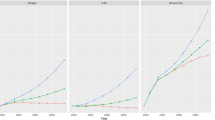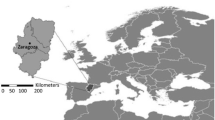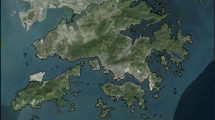Abstract
Previous assessments of the impacts of climate change on heat-related mortality use the “delta method” to create temperature projection time series that are applied to temperature–mortality models to estimate future mortality impacts. The delta method means that climate model bias in the modelled present does not influence the temperature projection time series and impacts. However, the delta method assumes that climate change will result only in a change in the mean temperature but there is evidence that there will also be changes in the variability of temperature with climate change. The aim of this paper is to demonstrate the importance of considering changes in temperature variability with climate change in impacts assessments of future heat-related mortality. We investigate future heat-related mortality impacts in six cities (Boston, Budapest, Dallas, Lisbon, London and Sydney) by applying temperature projections from the UK Meteorological Office HadCM3 climate model to the temperature–mortality models constructed and validated in Part 1. We investigate the impacts for four cases based on various combinations of mean and variability changes in temperature with climate change. The results demonstrate that higher mortality is attributed to increases in the mean and variability of temperature with climate change rather than with the change in mean temperature alone. This has implications for interpreting existing impacts estimates that have used the delta method. We present a novel method for the creation of temperature projection time series that includes changes in the mean and variability of temperature with climate change and is not influenced by climate model bias in the modelled present. The method should be useful for future impacts assessments. Few studies consider the implications that the limitations of the climate model may have on the heat-related mortality impacts. Here, we demonstrate the importance of considering this by conducting an evaluation of the daily and extreme temperatures from HadCM3, which demonstrates that the estimates of future heat-related mortality for Dallas and Lisbon may be overestimated due to positive climate model bias. Likewise, estimates for Boston and London may be underestimated due to negative climate model bias. Finally, we briefly consider uncertainties in the impacts associated with greenhouse gas emissions and acclimatisation. The uncertainties in the mortality impacts due to different emissions scenarios of greenhouse gases in the future varied considerably by location. Allowing for acclimatisation to an extra 2°C in mean temperatures reduced future heat-related mortality by approximately half that of no acclimatisation in each city.








Similar content being viewed by others
References
Beniston M, Diaz HF (2004) The 2003 heat wave as an example of summers in a greenhouse climate? Observations and climate model simulations for Basel, Switzerland. Global Planet Change 44:73–81 doi:10.1016/j.gloplacha.2004.06.006
Brazell AJ, McCabe GJ Jr, Verville HJ (1993) Incident solar radiation simulated by general circulation models for the southwestern United States. Clim Res 2:177–181 doi:10.3354/cr002177
Caesar J, Alexander L, Vose R (2006) Large-scale changes in observed daily maximum and minimum temperatures: creation and analysis of a new gridded data set. J Geophys Res 111. doi:10.1029/2005JD006280
Coles S (2001) An introduction to statistical modelling of extreme values. Springer, London
Conti S, Meli P, Minelli G, Solimini R, Toccaceli V, Vichi M, Beltrano C, Perini L (2005) Epidemiologic study of mortality during the summer 2003 heat wave in Italy. Environ Res 98:390–399 doi:10.1016/j.envres.2004.10.009
Davis RE, Knappenberger PC, Michaels PJ, Novicoff WM (2004) Seasonality of climate-human mortality relationships in US cities and impacts of climate change. Clim Res 26:61–76 doi:10.3354/cr026061
Déqué M (2007) Frequency of precipitation and temperature extremes over France in an anthropogenic scenario: model results and statistical correction according to observed values. Global Planet Change 57:16–26 doi:10.1016/j.gloplacha.2006.11.030
Dessai S (2003) Heat stress and mortality in Lisbon Part II. An assessment of the potential impacts of climate change. Int J Biometeorol 48:37–44 doi:10.1007/s00484-003-0180-4
Doherty R, Mearns LO (1999) NCAR conducts climate model evaluation. Acclimations 6:8
Donaldson GC, Kovats RS, Keatinge WR, McMicheal AJ (2001) Heat- and cold related mortality and morbidity and climate change. In: Maynard RL (ed) Health effects of climate change in the UK. Department of Health, London, pp 70–80
Folland CK, Karl TR, Christy JR, Clarke RA, Gruza GV, Jouzel J, Mann ME, Oerlemans J, Salinger MJ, Wang S-W (2001) Observed climate variability and change. In: Houghton JT, Ding Y, Griggs DJ, Noguer M, van der Linden PJ, Dai X, Maskell K, Johnson CA (eds) Climate change 2001: the scientific basis. Contribution of Working Group I to the Third Assessment Report of the Intergovernmental Panel on Climate Change. Cambridge University Press, Cambridge
Gordon C, Cooper C, Senior CA, Banks H, Gregory JM, Johns TC, Mitchell JFB, Wood RA (2000) The simulation of SST, sea ice extents and ocean heat transports in a version of the Hadley Centre coupled model without flux adjustments. Clim Dyn 16:147–168 doi:10.1007/s003820050010
Gosling SN, McGregor GR, Páldy A (2007) Climate change and heat-related mortality in six cities Part 1: model construction and validation. Int J Biometeorol 51:525–540 doi:10.1007/s00484-007-0092-9
Gosling SN, Lowe JA, McGregor GR, Pelling M, Malamud BD (2008) Associations between elevated atmospheric temperature and human mortality: a critical review of the literature. Clim Change. doi:10.1007/s10584-008-9441-x
Gregory JM, Stott PA, Cresswell DJ, Rayner NA, Gordon C, Sexton DMH (2002) Recent and future changes in Arctic sea ice simulated by the HadCM3 AOGCM. Geophys Res Lett 29. doi:10.1029/2001GL014575
Guest CS, Willson K, Woodward AJ, Hennessy K, Kalkstein LS, Skinner C, McMichael AJ (1999) Climate and mortality in Australia: retrospective study, 1979–1990, and predicted impacts in five major cities in 2030. Clim Res 13:1–15 doi:10.3354/cr013001
Gumbel EJ (1958) Statistics of extremes. Columbia University Press
Hayhoe K, Cayan D, Field CB, Frumhoff PC, Maurer EP, Miller NL, Moser SC, Schneider SH, Cahill KN, Cleland EE, Dale L, Drapek R, Hanemann RM, Kalkstein LS, Lenihan J, Lunch CK, Neilson RP, Sheridan SC, Verville JH (2004) Emissions pathways, climate change, and impacts on California. Proc Natl Acad Sci USA 101:12422–12427 doi:10.1073/pnas.0404500101
Honda Y, Ono M, Sasaki A, Uchiyama I (1998) Shift of the short term temperature mortality relationship by a climate factor: some evidence necessary to take account of in estimating the health effect of global warming. J Risk Res 1:209–220 doi:10.1080/136698798377132
Huth R, Kysely J, Pokorna L (2000) A GCM simulation of heatwaves, dry spells, and their relationships to circulation. Clim Change 46:29–60 doi:10.1023/A:1005633925903
Intergovernmental Panel on Climate Change (IPCC) (2007). Clim Change 2007: Impacts adaptation and vulnerability: summary for policymakers. http://www.ipcc.ch/
Kalkstein LS, Greene JS (1997) An evaluation of climate/mortality relationships in large U.S. cities and the possible impacts of a climate change. Environ Health Perspect 105:84–93 doi:10.2307/3433067
Kjellström E, Bärring L, Jacob D, Jones R, Lenderink G, Schär C (2007) Modelling daily temperature extremes: recent climate and future changes over Europe. Clim Change 81:249–265 doi:10.1007/s10584-006-9220-5
Knowlton K, Lynn B, Goldberg RA, Rosenzweig C, Hogrefe C, Rosenthal JC, Kinney PL (2007) Projecting heat-related mortality impacts under a changing climate in the New York City Region. Am J Public Health 11:2028–2034 doi:10.2105/AJPH.2006.102947
Kovats RS, Ebi K, Menne B (2003) Methods of assessing human health vulnerability and public health adaptation to climate change. Health and Global Environmental Change Series, No. 1. Copenhagen: World Health Organization, Health Canada, United Nations Environment Programme, World Meteorological Organization
Kueppers LM, Snyder MA, Sloan LC, Zavaleta ES, Fulfrost B (2005) Modelled regional climate change and California endemic oak ranges. Proc Natl Acad Sci USA 102:16281–16285 doi:10.1073/pnas.0501427102
McMichael AJ, Woodruff R, Whetton P, Hennessy K, Nicholls N, Hales S, Woodward A, Kjellstrom T (2003) Human health and climate change in Oceania: risk assessment 2002. Department of Health and Ageing, Canberra, Commonwealth of Australia
Mearns LO, Easterling W, Hays C, Marx D (2001) Comparison of agricultural impacts of climate change calculated from high and low resolution climate change scenarios: Part I. The uncertainty due to spatial scale. Clim Change 51:131–172 doi:10.1023/A:1012297314857
Meehl GA, Tebaldi C (2004) More intense, more frequent, and longer lasting heatwaves in the 21st Century. Science 305:994–997 doi:10.1126/science.1098704
Meehl GA, Karl T, Easterling DR, Changnon S, Pielke R Jr, Changnon D, Evans J, Groisman PY, Knutson TR, Kunkel KE, Mearns LO, Parmesan C, Pulwarty R, Root T, Sylves RT, Whetton P, Zwiersl F (2000) An introduction to trends in extreme weather and climate events: observations, socioeconomic impacts, terrestrial ecological impacts, and model projections. Bull Am Meteorol Soc 81:413–416 doi:10.1175/1520-0477(2000)081<0413:AITTIE>2.3.CO;2
Meehl GA, Washington WM, Collins WD, Arblaster JM, Hu A, Buja LE, Strand WG, Haiyan T (2005) How much more global warming and sea level rise? Science 307:1769–1772 doi:10.1126/science.1106663
Meehl GA, Stocker TF, Collins WD, Friedlingstein P, Gaye AT, Gregory JM, Kitoh A, Knutti R, Murphy JM, Noda A, Raper SCB, Watterson IG, Weaver AJ, Zhao Z-C (2007) Global climate projections. In: Solomon S, Qin D, Manning M, Chen Z, Marquis M, Averyt KB, Tignor M, Miller HL (eds) Climate change 2007: the physical science basis. Contribution of working Group I to the Fourth Assessment Report of the Intergovernmental Panel on Climate Change, Cambridge University Press, Cambridge
Mudholkar GS, George EO (1978) A remark on the shape of the logistic distribution. Biometrika 65:667–668 doi:10.1093/biomet/65.3.667
Nakićenović N, Swart R (2000) (eds) Special report on emission scenarios. Cambridge University Press, Cambridge
National Assessment Synthesis Team (2000) Climate change impacts on the United States: the potential consequences of climate variability and change. US Global Change Research Program, Washington, DC
Oke TR (1987) Boundary layer climates. Routledge, London
Palutikof JP, Winkler JA, Goodess CM, Andresen JA (1997) The simulation of daily temperature time series from GCM Output. Part I: comparison of model data with observations. J Clim 10:2497–2513 doi:10.1175/1520-0442(1997)010<2497:TSODTT>2.0.CO;2
Pascal M, Laaidi K, Ledrans M, Baffert E, Caserio-Schönemann C, Le Tertre A, Manach J, Medina S, Rudant J, Empereur-Bissonnet P (2006) France’s heat health watch warning system. Int J Biometeorol 50:144–153 doi:10.1007/s00484-005-0003-x
Pope VD, Gallani ML, Rowntree PR, Stratton RA (1999) The impact of new physical parametrizations in the Hadley Centre climate model-HadAM3. Clim Dyn 16:123–146 doi:10.1007/s003820050009
Salzmann N, Frei C, Vidale P-L, Hoelzle M (2007) The application of Regional Climate Model output for the simulation of high-mountain permafrost scenarios. Global Planet Change 56:188–202 doi:10.1016/j.gloplacha.2006.07.006
Schubert S (1998) Downscaling local extreme temperature changes in South-Eastern Australia from the CSIRO Mark2 GCM’. Int J Climatol 18:1419–1438 doi:10.1002/(SICI)1097-0088(19981115)18:13<1419::AID-JOC314>3.0.CO;2-Z
Skelly WC, Henderson-Sellers A (1996) Grid box or grid point: what type of data do GCMs deliver to climate impacts researchers? Int J Climatol 16:1079–1086 doi:10.1002/(SICI)1097-0088(199610)16:10<1079::AID-JOC106>3.0.CO;2-P
Smoyer KE (1993) Socio-demographic implications in summer weather-related mortality. MA thesis, University of Delaware, Newark
Stott P, Tett S, Jones G, Allen M, Mitchell J, Jenkins G (2000) External control of 20th century temperature by natural and anthropogenic forcings. Science 290:2133–2137 doi:10.1126/science.290.5499.2133
Stott P, Stone DA, Allen MR (2004) Human contribution to the European heatwave of 2003. Nature 432:610–614 doi:10.1038/nature03089
Tett SFB, Jones GS, Stott PA, Hill DC, Mitchell JFB, Allen MR, Ingram WJ, Johns TC, Johnson CE, Jones A, Roberts DL, Sexton DMH, Woodage MJ (2002) Estimation of natural and anthropogenic contributions to 20th century temperature change. J Geophys Res 107. doi:10.1029/2000JD000028
Tsvetsinkskaya EA, Mearns LO, Mavromatis T, Gao W, McDaniel L, Downtown MW (2003) The effect of spatial scale of climatic change scenarios on simulated maize, winter wheat, and rice production in the Southeastern United States. Clim Change 60:37–71 doi:10.1023/A:1026056215847
Wilks DS (1995) Statistical methods in the atmospheric sciences: an introduction. Academic Press, New York
Williams KD, Senior CA, Mitchell JFB (2001) Transient climate change in the Hadley Centre models: the role of physical processes. J Clim 14:2659–2674 doi:10.1175/1520-0442(2001)014<2659:TCCITH>2.0.CO;2
Willmott CJ (1981) On the validation of models. Phys Geogr 2:184–194
Wu P, Wood R, Stott P (2005) Human influence on increasing Arctic river discharges. Geophys Res Lett 32. doi:10.1029/2004GL021570
Acknowledgements
This study was supported with funding from the UK Natural Environment Research Council (NERC) and a Cooperative Awards in Sciences of the Environment (CASE) award from the UK Meteorological Office. Two anonymous reviewers are thanked for their comments on an earlier version of the manuscript.
Author information
Authors and Affiliations
Corresponding author
Rights and permissions
About this article
Cite this article
Gosling, S.N., McGregor, G.R. & Lowe, J.A. Climate change and heat-related mortality in six cities Part 2: climate model evaluation and projected impacts from changes in the mean and variability of temperature with climate change. Int J Biometeorol 53, 31–51 (2009). https://doi.org/10.1007/s00484-008-0189-9
Received:
Revised:
Accepted:
Published:
Issue Date:
DOI: https://doi.org/10.1007/s00484-008-0189-9




